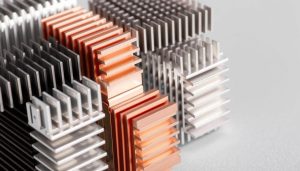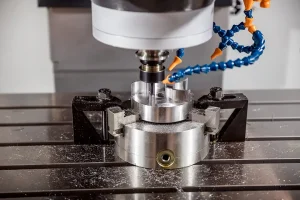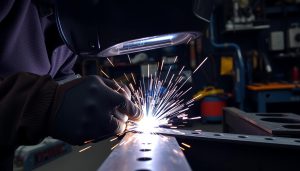In the world of metal fabrication and manufacturing, the choice between spot welding and tack welding can make a significant difference in the quality, strength, and versatility of your final product. These two welding techniques, while similar in some ways, offer distinct advantages and applications that are crucial to understand. In this article, we’ll delve into the key differences between spot weld and tack weld, exploring their definitions, processes, and the unique benefits they provide.
What is Spot Welding?
Spot welding is a widely used resistance welding technique that joins metal sheets or thin metal components through the application of electrical current. This process is particularly efficient in the automotive and manufacturing industries, where it plays a crucial role in assembling various metal parts.
Definition and Overview of Spot Welding
Spot welding is a type of resistance welding that creates a localized fusion between two or more metal sheets by passing an electrical current through them. The process involves clamping the metal sheets together and applying a high-intensity, short-duration electrical current, which generates heat at the point of contact, resulting in a spot weld.
How Spot Welding Works: The Process and Equipment
The spot welding process begins with the placement of the metal sheets between two electrodes, which are typically made of copper alloys. The electrodes apply a controlled amount of pressure to the metal sheets, ensuring proper contact. The electrical current is then passed through the electrodes, generating heat at the point of contact between the metal sheets. This heat causes the metal to melt and fuse, creating a strong, localized weld.
Advantages of Spot Welding
- Efficient for joining thin metal sheets and components
- Produces high-strength, durable welds
- Capable of high-volume, automated production
- Precise control over the weld size and location
- Cost-effective and energy-efficient compared to other welding methods
Spot welding’s ability to quickly and effectively join metal sheets makes it a popular choice in industries like automotive, appliance manufacturing, and metal fabrication, where the seamless assembly of components is crucial.
What is Tack Welding?
Tack welding is a versatile welding technique that plays a crucial role in many welding projects. It involves creating temporary temporary welds to hold workpieces in the desired positioning and alignment before the final welding process. Unlike spot welding, which produces permanent joints, tack welds are meant to be temporary, serving as a precursor to more robust welding methods.
Definition and Overview of Tack Welding
Tack welding is a welding technique that creates small, intermittent welds to temporarily hold two or more metal pieces together. These welds are strategically placed to maintain the proper positioning and alignment of the workpieces, ensuring a successful final welding process.
How Tack Welding Works: The Process and Equipment
During tack welding, the welder uses a welding gun or torch to create a series of short, localized welds at specific points along the joint. The size and placement of these tack welds are determined by the overall project requirements, ensuring the workpieces remain securely in place. Tack welding can be performed using various welding processes, including Shielded Metal Arc Welding (SMAW), Gas Tungsten Arc Welding (GTAW), and Gas Metal Arc Welding (GMAW).
Advantages of Tack Welding
- Facilitates accurate positioning and alignment of workpieces before final welding
- Allows for easy adjustments and modifications during the assembly process
- Provides a secure hold for the workpieces, preventing movement or distortion
- Enables the creation of complex, multi-piece structures by holding components in place
- Offers a cost-effective solution for temporary joints and assemblies
Tack welding is a valuable technique that supports the overall welding process, ensuring the proper positioning and alignment of workpieces before they are permanently joined.
Spot Welding vs Tack Welding: Key Differences
When it comes to the world of welding, spot welding and tack welding are two distinct techniques that serve different purposes. Understanding the key differences between these methods is crucial for choosing the right approach for your welding comparison, joint strength, and manufacturing efficiency requirements.
Permanent vs Temporary Joints
The primary distinction lies in the nature of the joints they create. Spot welding produces permanent, high-strength connections, making it ideal for applications where a durable, long-lasting bond is needed. Tack welding, on the other hand, creates temporary joints that are often used for alignment, positioning, or as a precursor to a more permanent weld.
Applications: When to Use Spot Welding vs Tack Welding
Spot welding excels in high-volume, industrial manufacturing settings, where speed and efficiency are paramount. It is commonly used in the automotive industry, as well as for joining thin metal sheets in a wide range of applications. Tack welding, on the other hand, is more suitable for precision alignment, constructing structural frameworks, and providing temporary holds during the welding process.
Speed and Efficiency: Comparing the Two Techniques
Spot welding is generally faster and more efficient than tack welding, making it the preferred choice for mass production. The automated nature of spot welding allows for rapid, consistent, and high-quality welds, while tack welding is a more manual process that requires greater skill and time investment.
By understanding these key differences, you can make an informed decision on whether spot welding or tack welding is the best fit for your welding comparison, joint strength, and manufacturing efficiency needs.
Pros and Cons of Spot Welding
Spot welding is a versatile joining technique that boasts several advantages, making it a popular choice for various industries. However, like any manufacturing process, it also comes with some limitations that users should be aware of. Let’s dive into the pros and cons of spot welding to help you make an informed decision.
Benefits of Spot Welding
One of the primary benefits of spot welding is its ability to facilitate high-speed production and automation. The process is relatively quick, allowing for efficient assembly of components, especially in industries like automotive manufacturing. Spot welding also enables the joining of thin metal sheets, making it suitable for a wide range of applications where lighter materials are preferred.
- Fast and efficient welding process
- Suitable for high-volume production and automation
- Capable of joining thin metal sheets
- Cost-effective compared to other welding techniques
Limitations and Considerations of Spot Welding
While spot welding offers many advantages, it also comes with some limitations. One of the primary challenges is the material limitations of the process, which may struggle with thicker or harder materials. Additionally, the spot welding process can sometimes leave visible marks on the surface, which may be undesirable in certain applications.
- Limitations in welding thicker or harder materials
- Potential for visible surface marks or indentations
- Accuracy and alignment can be challenging for complex geometries
- Relatively small weld area compared to other welding techniques
By understanding both the advantages and limitations of spot welding, you can make an informed decision on whether this technique is the best fit for your specific welding requirements.

“Spot welding is a game-changer for industries that require high-speed, automated assembly processes, but users should carefully consider the material limitations and surface finishes before deciding on this technique.”
Pros and Cons of Tack Welding
Tack welding is a versatile technique that offers several advantages, but it also comes with its own set of considerations. Understanding the benefits and limitations of tack welding can help you make an informed decision about when to utilize this welding method.
Benefits of Tack Welding
One of the primary advantages of tack welding is its versatility. This technique can be used on a wide range of materials, including various metals, and it is particularly useful for achieving fit-up accuracy during the assembly process. Tack welding allows you to temporarily hold parts in place, ensuring a precise alignment before completing the final weld.
Another notable benefit of tack welding is the skill requirements. Compared to other welding techniques, tack welding generally requires a lower level of expertise, making it a more accessible option for some projects. This can be especially advantageous for small-scale or DIY tasks where access to highly skilled welders may be limited.
Limitations and Considerations of Tack Welding
While tack welding offers several advantages, it also has some limitations and considerations to keep in mind. Unlike spot welding, tack welds are not intended to be permanent, and they may not provide the same level of strength and durability as a full weld. This means that tack welds may need to be reinforced or replaced for applications that require a more robust joint.
Additionally, the skill requirements for tack welding, while generally lower than other welding techniques, still demand a certain level of proficiency. Poorly executed tack welds can lead to issues such as distortion, cracking, or even safety concerns. Proper training and adherence to best practices are essential to ensure the successful use of tack welding.
“Tack welding is a versatile technique that can be a valuable tool in the right circumstances, but it’s important to understand its limitations and use it appropriately.”
Applications of Spot Welding
Spot welding has become an indispensable technique in various industries, showcasing its versatility and efficiency. From the bustling car body assembly lines to the intricate world of appliance manufacturing and the cutting-edge electronics industry, this welding method has carved its niche as a go-to solution for high-volume production and thin metal sheet joining.
Automotive and High-Volume Manufacturing
The automotive industry is a prime example of where spot welding shines. The car body assembly process heavily relies on this technique to create sturdy, reliable structures. Spot welding’s speed and precision make it the preferred choice for joining the numerous metal panels that comprise a vehicle’s frame, ensuring a consistent and secure construction.
Beyond the automotive sector, spot welding’s prowess extends to other high-volume manufacturing environments. Appliance manufacturers leverage this technique to efficiently assemble components, from refrigerators and washing machines to air conditioners and dishwashers. The electronics industry also benefits from spot welding, as it allows for the precise joining of delicate metallic parts in products like smartphones, laptops, and other consumer electronics.
Thin Metal Sheet Joining and Industrial Applications
Spot welding’s versatility shines when it comes to joining thin metal sheets, a common requirement in various industrial applications. From the creation of air conditioning vents and ductwork to the fabrication of metal furniture and office equipment, this welding method ensures a reliable and visually appealing bond without compromising the integrity of the underlying materials.
Additionally, spot welding finds widespread use in the construction industry, where it aids in the assembly of structural components, such as steel frames and supports. Its ability to create strong, localized joints makes it an invaluable tool for these applications, contributing to the overall safety and stability of the final structures.

“Spot welding’s speed and precision make it the preferred choice for joining the numerous metal panels that comprise a vehicle’s frame, ensuring a consistent and secure construction.”
Applications of Tack Welding
Tack welding, while primarily used for temporary joint formation, finds a wide range of applications in various industries. From precision alignment and temporary holding to its critical role in construction and structural welding, this versatile technique is an essential tool for complex fabrication projects, shipbuilding, and aerospace engineering.
Precision Alignment and Temporary Holding
One of the primary applications of tack welding is the precise alignment and temporary holding of components. This is particularly crucial in industries where accurate positioning and alignment are paramount, such as aerospace and shipbuilding. Tack welds allow manufacturers to securely hold parts in place during the assembly process, ensuring perfect fit and alignment before applying the final, permanent welds.
Use in Construction and Structural Welding
Tack welding plays a vital role in the construction and structural welding industries. In the fabrication of large-scale structures, such as buildings, bridges, and industrial equipment, tack welds are used to temporarily join components, enabling precise positioning and easier handling during the assembly process. This temporary joining method facilitates the efficient and accurate completion of complex fabrication projects.
Additionally, tack welding is commonly used in the shipbuilding industry, where it helps to align and temporarily secure the various structural elements of a vessel, ensuring a seamless and sturdy final product.
“Tack welding is an indispensable technique in industries where precision and temporary holding are crucial for successful project completion.”
Why Choose Shixinproto for Your Welding Needs?
As a leading provider of professional welding services, Shixinproto has established a reputation for unparalleled quality assurance and custom fabrication capabilities. With a team of skilled technicians and state-of-the-art equipment, Shixinproto is the trusted choice for businesses across a wide range of industries, from automotive manufacturing to construction and beyond.
At Shixinproto, we take pride in our expertise in both spot welding and tack welding, ensuring that our clients receive tailored solutions to meet their unique needs. Whether you require precise, permanent joints or temporary alignments, our experienced professionals have the knowledge and resources to deliver exceptional results, every time.
Committed to excellence, Shixinproto’s unwavering focus on quality assurance sets us apart from the competition. We employ rigorous testing and quality control measures to guarantee the integrity of every weld, giving our clients the peace of mind that their projects are in the hands of true professionals. From custom fabrication to seamless integration, Shixinproto is your one-stop-shop for all your welding requirements.





